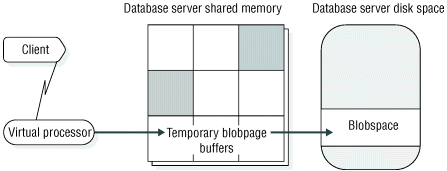Creation of blobpage buffers
To receive simple large object data from the application process, the database server creates a pair of blobspace buffers, one for reading and one for writing, each the size of one blobspace blobpage. Each user has only one set of blobspace buffers and, therefore, can access only one simple large object at a time.
Simple large object data is transferred from the client-application process to the database server in 1 KB segments. The database server begins filling the blobspace buffers with the 1 KB pieces and attempts to buffer two blobpages at a time. The database server buffers two blobpages so that it can determine when to add a forwarding pointer from one page to the next. When it fills the first buffer and discovers that more data remains to transfer, it adds a forward pointer to the next page before it writes the page to disk. When no more data remains to transfer, the database server writes the last page to disk without a forward pointer.
When the thread begins writing the first blobspace buffer to disk, it attempts to perform the I/O based on the user-defined blobpage size. For example, if the blobpage size is 32 KB, the database server attempts to read or write the data in 32,768-byte increments. If the underlying hardware (such as the disk controller) cannot transfer this amount of data in a single operation, the operating-system kernel loops internally (in kernel mode) until the transfer is complete.

Blobspace blobpages are allocated and tracked with the free-map page. Links that connect the blobpages and pointers to the next blobpage segments are created as necessary.
A record of the operation (insert, update, or delete) is written to the logical-log buffer.